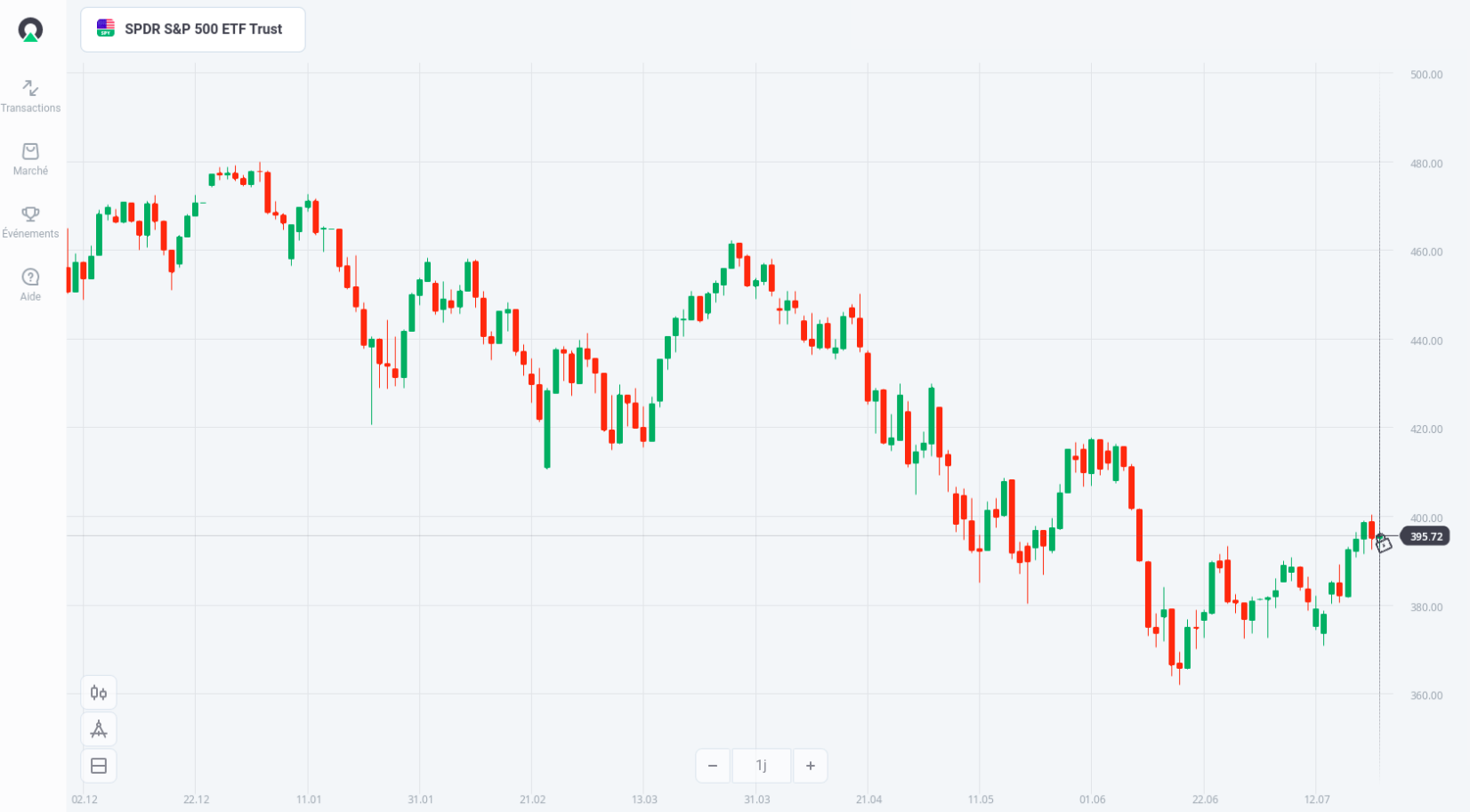
Born from an era of dwindling trust for traditional third parties, blockchain technology proposes transparency and disintermediation, financial autonomy and a high level of security. The technology attracts new users daily and facilitates millions of transactions.
Considered the biggest economic revolution since the internet, blockchain is a technology that will change our way of thinking, but not many know how a blockchain works.
In this article, you’ll learn what a blockchain is, how it works and how they can benefit you. 😉
Contents:
- What is a blockchain in simple terms?
- How does a blockchain work?
- What are blockchains used for?
- Pros and cons of a blockchain
- How traders can benefit from blockchain
- Blocks on the horizon
Interact with the underlined words and green dots to get additional details and explanations.
Additional context for the visuals.
Explanations and definitions of terms.
What is a blockchain in simple terms?
A blockchain is a decentralized peer-to-peer network that serves as a method for storing and transmitting information. Protected by cryptography, Blockchains are unfalsifiable and transparent because their data is decentralized and verified by a network of nodes. An identical version of the blockchain is distributed across all network nodes, which assures the blockchain’s integrity, and anyone can verify the entire blockchain at any moment.
Blockchains have a range of applications as a result of their transaction speed, automation and security features.
The essential characteristics of blockchain technology are:
- Disintermediation
- Transparency
- Safety and security
- Independence
Part of the reason why blockchains are so secure is their method of verifying new information. The cryptographic hash of each new block is based on that of the block before it, thus making a “chain” of related data. Therefore, if anyone tries to alter data on the ledger, all other blocks reject it because their cryptographic hashes become incompatible, thus rendering the node’s altered version of the blockchain invalid.
The different classes of blockchains:
1️⃣ Public blockchain
Like the Bitcoin blockchain, public blockchains are unrestricted with no particular entry requirements other than hardware. Anyone with enough disk space on their computer can become a functioning part of the network, and the more people join the network, the stronger the network’s security.
Public blockchains have a source code that is publicly available for anyone to check and audit, and are the ideal option for a decentralized solution. Due to being completely public, however, all transactions and wallet addresses are visible to anyone. New block creation on public blockchains depends on the consensus mechanism governing the network.
2️⃣ Private blockchain
On the other hand, private blockchains are blockchains with barriers to entry such as invitation or other prerequisites. New blocks are created either by a centralized entity that has the sole right to perform audits and manage the database, or by validators chosen by the centralized entity. The public cannot read all the data that is on the network and may not have access to the network’s source code.
Consensus mechanisms
The manner in which a blockchain’s new blocks are formed is governed by a consensus mechanism. In order to make new blocks, network participants need to agree on which transactions are valid and which are not, as some bad actors may try to double-spend network tokens. Participants also need to agree on the correct version of the blockchain’s history, as bad actors may try to alter previous data. Consensus mechanisms deter such malicious activity by making it, essentially, not worth the effort. As long as 51% of network participants do not agree on the falsified data, or one bad actor does not take control of 51% of the network, the network is secure.
Consensus mechanisms deter malicious activity by making it, essentially, not worth the effort.
Below are some of the most common types of consensus mechanisms:
Proof of work
New blocks are created by nodes or miners using computational power, or “work,” to solve or “hash” a complex mathematical problem, so miners with more computational power have a higher chance of validating the next block. The new blocks need to be validated by a majority of network participants. This consensus is truly decentralized, as anyone can become a validator in the peer-to-peer network, but not scalable due to a low network transaction and block finalization speed. Bitcoin and Litecoin are both proof-of-work blockchains.
Proof of stake
Participants who own the network’s native cryptocurrency stake their tokens into smart contracts to become block validators, whose responsibility it is to participate in block creation and check that new blocks are valid. Following its Merge, the Ethereum network has a proof-of-stake protocol.
Proof of authority
Block creators are made by participants staking their reputation rather than cryptocurrency. As validators, governmental and other large organizations cannot afford to besmirch their own reputation by validating new blocks incorrectly or otherwise jeopardizing the system, so this consensus is particularly useful for personal, education and healthcare data verification and security.
How does a blockchain work?
A blockchain works as a chain of blocks that store all types of information. We can refer to it as a database containing the history of every transaction — a ledger.
On this ledger, blockchains instantaneously track all transactions that occur on the network, no matter where on the network they occur. Data is recorded on the blocks via transactions, and once a block is full, new information is compiled to be recorded on the next, new block. Blocks are made according to their consensus mechanism, whether that be by network nodes using computational power to hash a complex mathematical problem or approved validators creating them at certain time intervals. Once a node, miner or validator has fulfilled the requirements for new block creation, a new block is formed, the creator receives a reward, and the new block is verified by validators across the network.
Blockchains achieve their immutability via the consensus mechanism written into the network’s source code, allowing several innovative cryptographic processes to protect blocks — new and old — from modifications.
Let’s take a closer look at how a blockchain’s function plays out:
A transaction is initiated between two parties, X and Y
The new transaction request was certified by the digital signature, or private key, of X.
The transaction is transmitted across all the blockchain network nodes
All blockchain verifiers receive a copy of the transaction. They verify and validate the transaction details using automatic processing algorithms.
Placing the transaction in a block
Once validated, transactions are compiled into blocks created by miners. Each block has a digital marker or hash from the previous block in the chain, which certifies its validity.
Finding the correct hash
The goal of hashing is to find the code of the next block and validate it. The miner who discovers the correct hash is rewarded, typically with cryptocurrency.
Sending the updated blockchain
The transaction from X to Y is valid, and the wallet of Y receives the funds. The fact of this transaction remains on the blockchain permanently.
What are blockchains used for?
Blockchain technology has the potential to change the global economy and revolutionize multiple sectors, including finance, healthcare, art and the music industry. Its primary purpose of storing and sharing digital information with clarity and safety has a number of applications that range from verification and tracking of real-world objects to autonomously transacting value based on certain criteria. Blockchain partly makes up the technological backbone of the incoming Fourth Industrial Revolution and is the main technology upon which Web3 is based.
Solutions
- Cryptocurrencies
- Smart contracts
- Non-fungible tokens (NFTs)
- Electronic voting
- Copyright certification
- Supply chain and tracking optimization
Pros and cons of a blockchain
Pros:
- Decentralization
- Provides a higher level of transparency
- Speed of transactions
- Data reliability
- Removes the need for a third-party or intermediary
Cons:
- Energy consumption
- Technological complexity hinders accessibility
- Unclear regulatory status
How traders can benefit from blockchain
There are several ways traders can get the best out of blockchain technology. One of them is using cryptocurrency to make a deposit on your Olymp Trade account.
Another way to benefit from blockchain is by using different assets such as:
- Cryptocurrency
- Company stocks
- ETFs (exchange-traded funds)
1️⃣ Cryptocurrency
Bitcoin or
Ethereum are among the most widespread cryptocurrencies powered by the blockchain. The price of most cryptocurrencies tends to follow the ebbs and flows of the Bitcoin price, with Ethereum coming in at a close second for popularity. While Bitcoin is considered a store of value, Ethereum is primarily a platform upon which other blockchain-based solutions are built.

2️⃣ Company stocks
Big corporations are investing in blockchain or already using it. They know that blockchain is the future and are investing significant resources to build and integrate their own blockchain systems, or directly purchase crypto assets. Some of the companies at the forefront of blockchain in business include IBM,
Coinbase and
Robinhood, all of which can be traded on via Olymp Trade.

3️⃣ ETFs
Exchange-traded funds are a great way to invest passively for the long term. While blockchain is booming, trading ETFs allows you to profit from multiple blockchain-based projects. For example, the SPDR S&P 500 ETF trust invests in companies like Nvidia, a major producer of the computer hardware necessary for mining, and
Tesla, which uses two blockchain solutions.

Blocks on the horizon
Blockchain technology provides countless opportunities and solutions to age-old problems, and it is helping pave the path forward for humanity. Now that you know the finer details of what a blockchain is and how it works, you can start learning the different types of cryptocurrency if you’re not already familiar with them and how to scalp trade crypto. You may even start getting your own ideas about how to solve some of today’s issues via blockchain innovations.
That said, choosing the right platform will give you an edge over other traders, so it’s important to make sure you’re provided with useful tools and a low barrier to entry. Fortunately, Olymp Trade provides both, so come check it out!
Trade on CryptocurrenciesRisk warning: The contents of this article do not constitute investment advice, and you bear sole responsibility for your trading activity and/or trading results.
A digital wallet or account where users can store their cryptocurrency. It contains a public key for receiving funds and a private key for user verification, and can be recovered at any time using a (typically) 12-word sequence.
When a network participant on a blockchain sends the same funds to two recipients.
The next generation of the internet and part of the incoming Fourth Industrial Revolution. It is largely based on blockchain technology and supports self-sovereign finances and identity.
Blockchain allows us to hold and transfer money without the intervention of a bank by utilizing a digital currency like Bitcoin or Ethereum.
An asset that retains its utility, value and purchasing power, no matter the market conditions.
A network that is hosted by multiple computers or nodes, where each acts as a server for the others to facilitate transactions.











